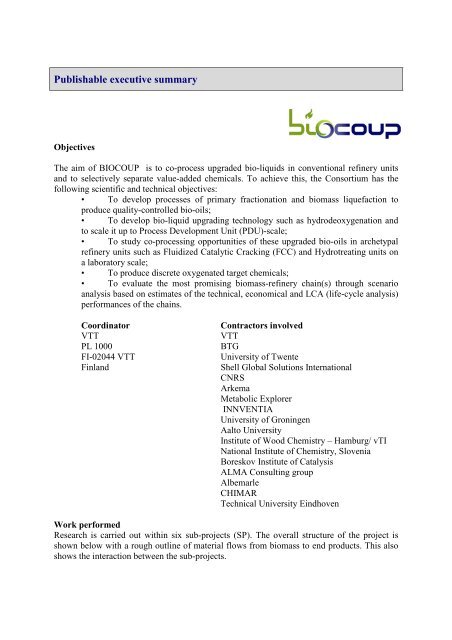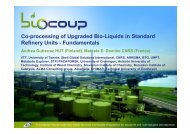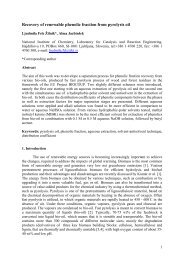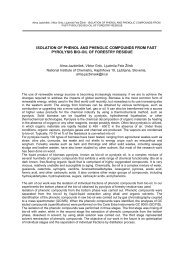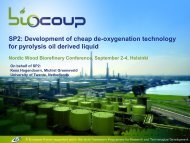to read the fourth Year Publishable Executive Summary - Biocoup
to read the fourth Year Publishable Executive Summary - Biocoup
to read the fourth Year Publishable Executive Summary - Biocoup
Create successful ePaper yourself
Turn your PDF publications into a flip-book with our unique Google optimized e-Paper software.
<strong>Publishable</strong> executive summary<br />
Objectives<br />
The aim of BIOCOUP is <strong>to</strong> co-process upgraded bio-liquids in conventional refinery units<br />
and <strong>to</strong> selectively separate value-added chemicals. To achieve this, <strong>the</strong> Consortium has <strong>the</strong><br />
following scientific and technical objectives:<br />
• To develop processes of primary fractionation and biomass liquefaction <strong>to</strong><br />
produce quality-controlled bio-oils;<br />
• To develop bio-liquid upgrading technology such as hydrodeoxygenation and<br />
<strong>to</strong> scale it up <strong>to</strong> Process Development Unit (PDU)-scale;<br />
• To study co-processing opportunities of <strong>the</strong>se upgraded bio-oils in archetypal<br />
refinery units such as Fluidized Catalytic Cracking (FCC) and Hydrotreating units on<br />
a labora<strong>to</strong>ry scale;<br />
• To produce discrete oxygenated target chemicals;<br />
• To evaluate <strong>the</strong> most promising biomass-refinery chain(s) through scenario<br />
analysis based on estimates of <strong>the</strong> technical, economical and LCA (life-cycle analysis)<br />
performances of <strong>the</strong> chains.<br />
Coordina<strong>to</strong>r<br />
VTT<br />
PL 1000<br />
FI-02044 VTT<br />
Finland<br />
Contrac<strong>to</strong>rs involved<br />
VTT<br />
BTG<br />
University of Twente<br />
Shell Global Solutions International<br />
CNRS<br />
Arkema<br />
Metabolic Explorer<br />
INNVENTIA<br />
University of Groningen<br />
Aal<strong>to</strong> University<br />
Institute of Wood Chemistry – Hamburg/ vTI<br />
National Institute of Chemistry, Slovenia<br />
Boreskov Institute of Catalysis<br />
ALMA Consulting group<br />
Albemarle<br />
CHIMAR<br />
Technical University Eindhoven<br />
Work performed<br />
Research is carried out within six sub-projects (SP). The overall structure of <strong>the</strong> project is<br />
shown below with a rough outline of material flows from biomass <strong>to</strong> end products. This also<br />
shows <strong>the</strong> interaction between <strong>the</strong> sub-projects.
Figure 1. Project structure<br />
SP1: Improving bio-oil quality and its primary fractionation<br />
Feeds<strong>to</strong>ck production for upgrading are developed in SP1 in three subtasks:<br />
- The in-situ filtering of pyrolysis vapours <strong>to</strong> yield an improved oil with a low ash<br />
content and low alkali metals for fur<strong>the</strong>r upgrading<br />
- Fractionation of bio oil <strong>to</strong> three main product streams <strong>to</strong> allow selective (catalytic)<br />
conversion steps for <strong>the</strong> fractions in SP2 such as hydrodeoxygenation (HDO),<br />
decarboxylation (DCO) and High Pressure Thermal Treatment (HPTT)<br />
- Production of high-sulphidity hardwood Kraft lignin <strong>to</strong> be characterized for<br />
liquefaction<br />
In <strong>the</strong> first task, both temperature and pressure drop were controlled across <strong>the</strong> hot gas vapor<br />
filter during a two hour run in <strong>the</strong> labora<strong>to</strong>ry reac<strong>to</strong>r using pine wood as feeds<strong>to</strong>ck. However,<br />
<strong>the</strong> same results could not be achieved for biomasses with a high ash content.<br />
Yields of <strong>the</strong> filtered oils were comparable <strong>to</strong> <strong>the</strong> yields obtained in <strong>the</strong> experiments using<br />
cyclones only. Integration of <strong>the</strong> filter in <strong>the</strong> fluidized bed prevents an increased pyrolysis<br />
vapor residence time as observed with external filtering of pyrolysis oil vapors, <strong>the</strong>reby<br />
preventing excessive secondary cracking reactions and lowering of <strong>the</strong> oil yield.<br />
The quality of <strong>the</strong> filtered oil is better than when cyclones are used: <strong>the</strong> filtered oil contains<br />
significantly less solids, alkali metals and ash as compared <strong>to</strong> cyclone oil. There were no<br />
significant differences in elemental composition of <strong>the</strong> pyrolysis oil produced via <strong>the</strong> filter<br />
line and cyclone line.<br />
Fractionation of bio oil is developed in <strong>the</strong> second task. The bio-oil is phase separated in<strong>to</strong> a<br />
water soluble aqueous phase, and a water insoluble lignin bot<strong>to</strong>m phase. After pyrolysis, <strong>the</strong><br />
aqueous upper phase was separated from <strong>the</strong> viscous lignin bot<strong>to</strong>m phase by ei<strong>the</strong>r letting <strong>the</strong><br />
liquid product stand in a measuring flask, or by centrifugation. From <strong>the</strong> aqueous upper phase<br />
sugar-like compounds were separated from <strong>the</strong> water and low molecular weight oxygen<br />
compounds by evaporation in vacuum. The purity of <strong>the</strong> fractions was determined by <strong>the</strong><br />
solubility based fractionation scheme.<br />
A higher bio-oil water content improves <strong>the</strong> phase separation, but at <strong>the</strong> same time <strong>the</strong><br />
recovery of ‘sugars’ and chemicals from <strong>the</strong> aqueous phase will be more difficult and<br />
expensive due <strong>to</strong> <strong>the</strong> high amount of water present. An optimum purity level for <strong>the</strong> separated<br />
fractions must be defined, before this concept can be verified on a Process Development Unit
(PDU) scale. The lignin and sugar fraction may be upgraded in<strong>to</strong> fuels, while <strong>the</strong> light volatile<br />
compounds in <strong>the</strong> aqueous phase may be used for chemicals.<br />
Alternative feeds for <strong>the</strong> BIOCOUP chain are developed in <strong>the</strong> third subtask. Labora<strong>to</strong>ry<br />
softwood and hardwood Kraft cooking at high (80%) and normal (35%) sulphidity has been<br />
performed. The softwood and hardwood lignins have been isolated from <strong>the</strong> Kraft cooks.<br />
After isolation all lignin samples are characterised with respect <strong>to</strong> chemical composition, ash<br />
content and <strong>the</strong>rmal properties .<br />
SP2: Develop smart upgrading strategies of pyrolysis oils <strong>to</strong> enable co-processing<br />
Three strategies have been studied for <strong>the</strong> upgrading of pyrolysis oils. These are<br />
hydrodeoxygenation (HDO), High Pressure Thermal Treatment (HPTT) and decarboxylation<br />
(DCO). In HDO, pyrolysis oil is stabilized with hydrogen and this upgrading route has been<br />
found <strong>to</strong> be more promising than HPTT and DCO.<br />
SP3 has shown that deep deoxygenation of pyrolysis oil is not necessary for <strong>the</strong> successful coprocessing<br />
of upgraded pyrolysis oil in lab scale FCC and hydrotreating units: oxygen levels<br />
up <strong>to</strong> 30% can be allowed. During pyrolysis oil upgrading, <strong>the</strong> stabilization of pyrolysis oil is<br />
thought <strong>to</strong> be more important than (deep) deoxygenation.<br />
HDO oil samples were produced using a wide variety of catalysts and process conditions.<br />
Process insight using model components, pyrolysis oil fractions and whole pyrolysis oil has<br />
helped in developing strategies <strong>to</strong> minimize hydrogen consumption and reaction times.<br />
Several new catalysts with good performance have been developed and tested. Suggestions<br />
for <strong>the</strong> definition of HDO oil quality with respect <strong>to</strong> co-processing have been made.<br />
It has been established that HPTT oil is not suitable for ei<strong>the</strong>r fur<strong>the</strong>r upgrading by HDO or<br />
direct processing in lab scale refinery units (plugging, miscibility problems with typical<br />
refinery feed). The polymerization behavior in HPTT processing has been studied as a<br />
function of process conditions. Several strategies <strong>to</strong> suppress polymerization/char formation<br />
during HPTT have been suggested, which also help in developing process concepts <strong>to</strong><br />
suppress polymerization in HDO. Work on HPTT was s<strong>to</strong>pped at M48. Experimental results<br />
on DCO so far show large similarities with HPTT: a strong polymerization and an oil product<br />
not suitable for co-processing.<br />
Work on DCO was s<strong>to</strong>pped at M48.<br />
A PDU has been designed and constructed <strong>to</strong> be able <strong>to</strong> produce sufficient quantities ( > 5 L)<br />
of HDO oil for pilot testing in refinery processes in SP3.<br />
SP3: Co-processing of upgraded bio-oils in archetypal refinery units<br />
In this sub-project, <strong>the</strong>re are two complementary activities: i) fundamental understanding is<br />
gained from closely studying <strong>the</strong> reactivity of <strong>the</strong>se bio-oils and model compounds ii) <strong>the</strong><br />
evaluation of <strong>the</strong>se bio-oils in lab scale refinery units.<br />
The impact on <strong>the</strong> hydrodesulpurisation performance has been studied by i) <strong>the</strong> addition of<br />
<strong>the</strong>se bio-oils ii) reaction temperature iii) hydrogenation catalyst. Possible degradation<br />
compounds have been identified which may be involved in a loss of efficiency of <strong>the</strong> HDS<br />
process. Insight in<strong>to</strong> <strong>the</strong> mechanism of converswion has been gained by examining <strong>the</strong> origin<br />
of <strong>the</strong> coke formation. In addition, use of <strong>the</strong> analytical technique Size Exclusion<br />
Chroma<strong>to</strong>graphy allows better identification of <strong>the</strong> fate of <strong>the</strong> higher molecular weight part of<br />
<strong>the</strong> bio-oil.
In parallel with <strong>the</strong> above activities, <strong>the</strong> upgraded bio-oils from SP2 have been extensively<br />
evaluated in lab scale Fluidised Catalytic Cracking or continuous hydrotreating units. In<br />
coprocessing <strong>the</strong>se upgraded bio-oils with representative standard FCC feeds such as a<br />
Vacuum Gas Oil or a Long Residue, similar gasoline range yields, with only slightly higher<br />
yields on coke and dry gas, are obtained, compared <strong>to</strong> <strong>the</strong> FCC feed alone. Continuous<br />
hydrotreating of <strong>the</strong> upgraded pyrolysis oil is technically feasible and affords a aromatic<br />
diesel-like bio-components. This suggests that <strong>the</strong> co-processing of upgraded bio-oils with<br />
FCC feeds using standard FCC conditions and catalysts can afford bio-hydrocarbons from a<br />
lignocellulosic feed source.<br />
SP4: Selective separation of discrete target oxygenates<br />
At M36 <strong>the</strong> extraction based isolation technologies and <strong>the</strong> distillation based fractionation<br />
technologies for aldehydes, phenolics and acids have been optimized. The main technology<br />
objective for <strong>the</strong> M37-M48 period was <strong>the</strong> establishment of detailed models and exprimental<br />
data on <strong>the</strong> optimized isolation and fractionation technologies required for <strong>the</strong> conceptual<br />
process designs and economical feasibility evaluations. This work has been completed and by<br />
<strong>the</strong> start of <strong>the</strong> last project year <strong>the</strong> required models and experimental data conducted have<br />
been established for all isolation and fractionation technologies<br />
Using <strong>the</strong> optimized technologies optimal fractions glycoaldehyde, phenolics and acid acid<br />
loaded extractant were produced and delivered <strong>to</strong> <strong>the</strong> SP4 partners. These fractions were used<br />
in combination with some earlier produced optimized fractions for chemicals/product<br />
syn<strong>the</strong>sis and performance evaluation. The improved aldehyde fraction and phenolics fraction<br />
has been evaluated in wood panels. The results showed that <strong>the</strong> aldehyde fraction increases<br />
<strong>the</strong> shear strength of <strong>the</strong> wood panels. The improved phenolics fraction allowed for slightly<br />
higher substitution of chemical phenolics. More detailed product evaluations of bioliquid<br />
based adhesives have demonstrated a general improvement of adhesive properties of bioliquid<br />
derived adhesives over chemical derived adhesives. The feasibility of biochemical reduction<br />
of bioliquid derived glycoaldehyde in<strong>to</strong> ethylene glycol has been demonstrated as well as <strong>the</strong><br />
production of bioliquid derived acetic acid.<br />
SP5: Scenario analysis<br />
A techno-economic analysis of <strong>the</strong> base production chain as well as two variants of <strong>the</strong><br />
BIOCOUP concept has been assessed and compared <strong>to</strong> an earlier reference chain, which was<br />
based entirely on state-of-<strong>the</strong>-art literature knowledge.<br />
Compared <strong>to</strong> <strong>the</strong> reference case assessed previously, <strong>the</strong> base concept has <strong>the</strong> following new<br />
features, which have been experimentally developed within <strong>the</strong> project:<br />
- Hydrodeoxygenation (HDO) of bio oil<br />
- Recovery of chemicals from <strong>the</strong> aqueous phase from <strong>the</strong> HDO (at <strong>the</strong> time of reporting not<br />
fully developed)<br />
- Co-upgrading of <strong>the</strong> HDO oil in a refinery Fluid Catalytic Cracker (FCC)<br />
HDO carried out at 340 ºC is <strong>the</strong> most competitive concept, in which a relatively low<br />
proportion of chemicals is produced. HDO at 230 ºC is <strong>the</strong> least competitive; <strong>the</strong> reference<br />
case lies between <strong>the</strong>se two alternatives. When <strong>the</strong> amount of chemicals is increased, <strong>the</strong><br />
competitiveness of <strong>the</strong> HDO340 is slightly improved. The competitiveness of <strong>the</strong> HDO230<br />
improves considerably when <strong>the</strong> value and amount chemicals are increased.
None of <strong>the</strong> alternatives are competitive with conventional fuels at current prices. The<br />
reference case becomes <strong>the</strong> most competitive of <strong>the</strong> chains compared, when <strong>the</strong> price of<br />
gasoline is 1.5 times above current prices. Both <strong>the</strong> reference case and HDO340 have a<br />
positive net present value, when <strong>the</strong> price of gasoline is 1.7 times higher than now.<br />
SP6: Transversal activities<br />
The SP6 activities run for <strong>the</strong> entire project and <strong>the</strong>y aim <strong>to</strong> facilitate <strong>the</strong> achievement of <strong>the</strong><br />
project objectives. Dissemination is ongoing with an increasing number of conference<br />
presentations and publications being submitted <strong>to</strong> peer-reviewed journals. A BIOCOUP<br />
workshop also <strong>to</strong>ok place in Helsinki at <strong>the</strong> second Nordic wood biorefinery conference.<br />
Details of <strong>the</strong>se activities can be found on <strong>the</strong> BIOCOUP website www.biocoup.eu.<br />
A watch is being kept on standardisation activities, <strong>to</strong> raise <strong>the</strong> awareness of standards<br />
organisations and o<strong>the</strong>r relevant networks and associations on both <strong>the</strong> activity within<br />
BIOCOUP and how this can contribute <strong>to</strong> <strong>the</strong> development of existing or new standards and<br />
work practices.<br />
Training activities organised by BIOCOUP have included two 1-week long courses held at<br />
M11 and M35 and organised by Aal<strong>to</strong> (<strong>the</strong>n acting as TKK). These were very successful with<br />
lectures and attendees from both industry and universities. Training is also on-going within<br />
<strong>the</strong> consortium so that <strong>the</strong> understanding of <strong>the</strong> many aspects associated with <strong>the</strong> biorefinery<br />
concept can be developed.<br />
The project management activities remain essential for managing this large Integrated Project<br />
with 17 partners and ensuring that <strong>the</strong> resources are used most effectively.


